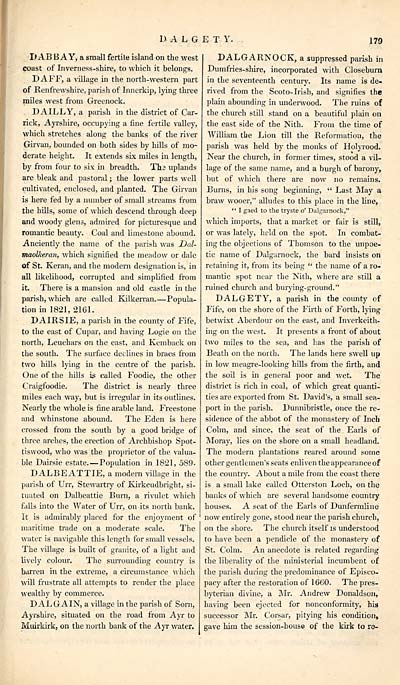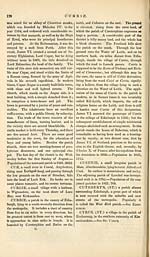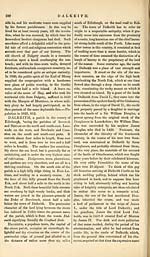Gazetteer of Scotland > Volume 1
(207) Page 179 - DAB
Download files
Complete book:
Individual page:
Thumbnail gallery: Grid view | List view

D A L G E T Y
179
I>AB B A Y, a small fertile island on the west
coast of Inverness-shire, to which it belongs.
DAFF, a village in the north-western part
of Renfrewshire, parish of Innerkip, lying three
miles west from Greenock.
DAILLY, a parish in the district of Car-
rick, Ayrshire, occupying a fine fertile valley,
which stretches along the banks of the river
Girvan, bounded on both sides by hills of mo-
derate height. It extends six miles in length,
by from four to six in breadth. Thj uplands
are bleak and pastoral ; the lower parts well
cultivated, enclosed, and planted. The Girvan
is here fed by a number of small streams from
the hills, some of which descend through deep
and woody glens, admired for picturesque and
romantic beauty. Coal and limestone abound.
Anciently the name of the parish was Dal-
maoUieran, which signified the meadow or dale
of St. Keran, and the modern designation is, in
all likelihood, corrupted and simplified from
it. There is a mansion and old castle in the
parish, which are called Kilkerran. — Popula-
tion in 1821,2161.
DAIRSIE, a parish in the county of Fife,
to the east of Cupar, and having Logie on the
north, Leuchars on the east, and Kemback on
the south. The surface declines in braes from
two hills lying in the centre of the parish.
One of the hills is called Foodie, the other
Craigfoodie. The district is nearly three
miles each way, but is irregular in its outlines.
Nearly the whole is fine arable land. Freestone
and whinstone abound. The Eden is here
crossed from the south by a good bridge of
three arches, the erection of Archbishop Spot-
tiswood, who was the proprietor of the valua-
ble Dairsie estate. — Population in 1821, 589.
DALBEATTIE, a modern village in the
parish of Urr, Stewartry of Kirkcudbright, si-
tuated on Dalbeattie Burn, a rivulet which
falls into the Water of Urr, on its north bank.
It is admirably placed for the enjoyment of
maritime trade on a moderate scale. The
water is navigable this length for small vessels.
The village is built of granite, of a light and
lively colour. The surrounding country is
barren in the extreme, a circumstance which
will frustrate all attempts to render the place
wealthy by commerce.
DAL GAIN, a village in the parish of Sorn,
Ayrshire, situated on the road from Ayr to
Muirkirk, on the north bank of the Ayr water.
DALGARNOCK, a suppressed parish in
Dumfries-shire, incorporated with Closeburn
in the seventeenth century. Its name is de-
rived from the Scoto-Irish, and signifies the
plain abounding in underwood. The ruins of
the church still stand on a beautiful plain on
the east side of the Nith. From the time of
William the Lion till the Reformation, the
parish was held by the monks of Holyrood.
Near the church, in former times, stood a vil-
lage of the same name, and a burgh of barony,
but of which there are now no remains.
Burns, in his song beginning, " Last May a
braw wooer," alludes to this place in the line,
" I gaed to the tryste o' Dalgarnock,"
which imports, that a market or fair is still,
or was lately, held on the spot. In combat-
ing the objections of Thomson to the unpoe-
tic name of Dalgarnock, the bard insists on
retaining it, from its being " the name of a ro-
mantic spot near the Nith, where are still a
ruined church and burying-ground."
DALGETY, a parish in the county of
Fife, on the shore of the Firth of Forth, lying
betwixt Aberdour on the east, and Inverkeith-
ing on the west. It presents a front of about
two miles to the sea, and has the parish of
Beath on the north. The lands here swell up
in low meagre-looking hills from the firth, and
the soil is in general poor and wet. The
district is rich in coal, of which great quanti-
ties are exported from St. David's, a small sea-
port in the parish. Dunnibristle, once the re-
sidence of the abbot of the monastery of Inch
Colm, and since, the seat of the Earls of
Moray, lies on the shore on a small headland.
The modern plantations reared around some
other gentlemen's seats enliven the appearance of
the country. About a mile from the coast there
is a small lake called Otterston Loch, on the
banks of which are several handsome country
houses. A seat of the Earls of Dunfermline
now entirely gone, stood near the parish church,
on the shore. The church itself is understood
to have been a pendicle of the monastery of
St. Colm. An anecdote is related regarding
the liberality of the ministerial incumbent of
the parish during the predominance of Episco-
pacy after the restoration of 1660. The pres-
byterian divine, a Mr. Andrew Donaldson,
having been ejected for nonconformity, his
successor Mr. Corsar, pitying his condition*
gave him the session-house of the kirk to ro-
179
I>AB B A Y, a small fertile island on the west
coast of Inverness-shire, to which it belongs.
DAFF, a village in the north-western part
of Renfrewshire, parish of Innerkip, lying three
miles west from Greenock.
DAILLY, a parish in the district of Car-
rick, Ayrshire, occupying a fine fertile valley,
which stretches along the banks of the river
Girvan, bounded on both sides by hills of mo-
derate height. It extends six miles in length,
by from four to six in breadth. Thj uplands
are bleak and pastoral ; the lower parts well
cultivated, enclosed, and planted. The Girvan
is here fed by a number of small streams from
the hills, some of which descend through deep
and woody glens, admired for picturesque and
romantic beauty. Coal and limestone abound.
Anciently the name of the parish was Dal-
maoUieran, which signified the meadow or dale
of St. Keran, and the modern designation is, in
all likelihood, corrupted and simplified from
it. There is a mansion and old castle in the
parish, which are called Kilkerran. — Popula-
tion in 1821,2161.
DAIRSIE, a parish in the county of Fife,
to the east of Cupar, and having Logie on the
north, Leuchars on the east, and Kemback on
the south. The surface declines in braes from
two hills lying in the centre of the parish.
One of the hills is called Foodie, the other
Craigfoodie. The district is nearly three
miles each way, but is irregular in its outlines.
Nearly the whole is fine arable land. Freestone
and whinstone abound. The Eden is here
crossed from the south by a good bridge of
three arches, the erection of Archbishop Spot-
tiswood, who was the proprietor of the valua-
ble Dairsie estate. — Population in 1821, 589.
DALBEATTIE, a modern village in the
parish of Urr, Stewartry of Kirkcudbright, si-
tuated on Dalbeattie Burn, a rivulet which
falls into the Water of Urr, on its north bank.
It is admirably placed for the enjoyment of
maritime trade on a moderate scale. The
water is navigable this length for small vessels.
The village is built of granite, of a light and
lively colour. The surrounding country is
barren in the extreme, a circumstance which
will frustrate all attempts to render the place
wealthy by commerce.
DAL GAIN, a village in the parish of Sorn,
Ayrshire, situated on the road from Ayr to
Muirkirk, on the north bank of the Ayr water.
DALGARNOCK, a suppressed parish in
Dumfries-shire, incorporated with Closeburn
in the seventeenth century. Its name is de-
rived from the Scoto-Irish, and signifies the
plain abounding in underwood. The ruins of
the church still stand on a beautiful plain on
the east side of the Nith. From the time of
William the Lion till the Reformation, the
parish was held by the monks of Holyrood.
Near the church, in former times, stood a vil-
lage of the same name, and a burgh of barony,
but of which there are now no remains.
Burns, in his song beginning, " Last May a
braw wooer," alludes to this place in the line,
" I gaed to the tryste o' Dalgarnock,"
which imports, that a market or fair is still,
or was lately, held on the spot. In combat-
ing the objections of Thomson to the unpoe-
tic name of Dalgarnock, the bard insists on
retaining it, from its being " the name of a ro-
mantic spot near the Nith, where are still a
ruined church and burying-ground."
DALGETY, a parish in the county of
Fife, on the shore of the Firth of Forth, lying
betwixt Aberdour on the east, and Inverkeith-
ing on the west. It presents a front of about
two miles to the sea, and has the parish of
Beath on the north. The lands here swell up
in low meagre-looking hills from the firth, and
the soil is in general poor and wet. The
district is rich in coal, of which great quanti-
ties are exported from St. David's, a small sea-
port in the parish. Dunnibristle, once the re-
sidence of the abbot of the monastery of Inch
Colm, and since, the seat of the Earls of
Moray, lies on the shore on a small headland.
The modern plantations reared around some
other gentlemen's seats enliven the appearance of
the country. About a mile from the coast there
is a small lake called Otterston Loch, on the
banks of which are several handsome country
houses. A seat of the Earls of Dunfermline
now entirely gone, stood near the parish church,
on the shore. The church itself is understood
to have been a pendicle of the monastery of
St. Colm. An anecdote is related regarding
the liberality of the ministerial incumbent of
the parish during the predominance of Episco-
pacy after the restoration of 1660. The pres-
byterian divine, a Mr. Andrew Donaldson,
having been ejected for nonconformity, his
successor Mr. Corsar, pitying his condition*
gave him the session-house of the kirk to ro-
Set display mode to: Large image | Transcription
Images and transcriptions on this page, including medium image downloads, may be used under the Creative Commons Attribution 4.0 International Licence unless otherwise stated. ![]()
| Gazetteers of Scotland, 1803-1901 > Gazetteer of Scotland > Volume 1 > (207) Page 179 - DAB |
|---|
| Permanent URL | https://digital.nls.uk/97426846 |
|---|
| Description | Volume I: Abbey to Glenartney. |
|---|---|
| Attribution and copyright: |
|
| Description | By Robert Chambers and William Chambers. Glasgow: Blackie & Son, 1838. 2 volumes. |
|---|---|
| Shelfmark | NF.1461.g.7 |
| Additional NLS resources: | |

